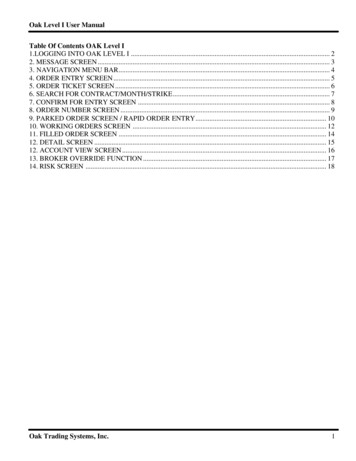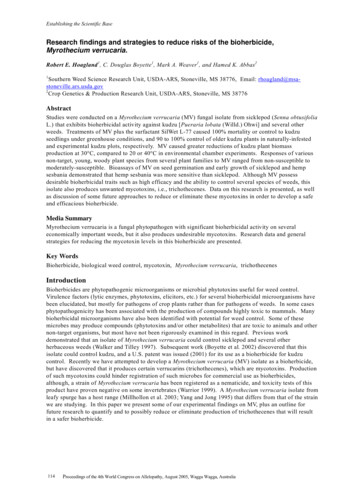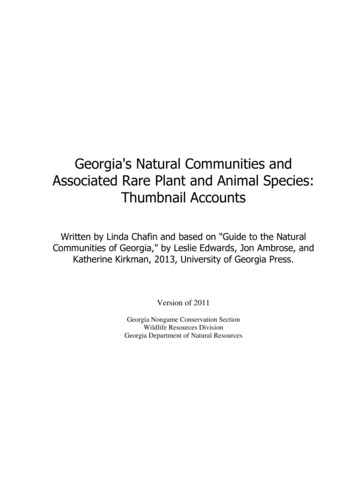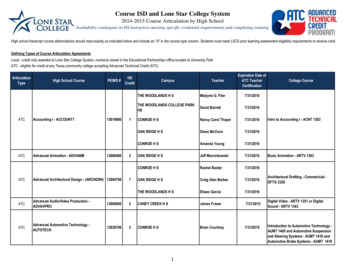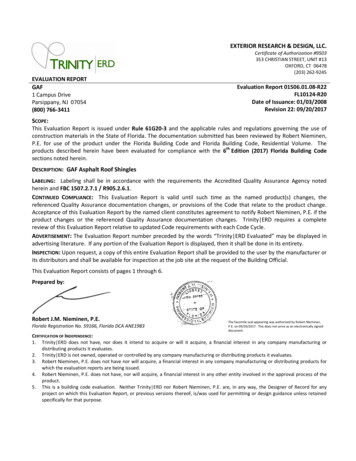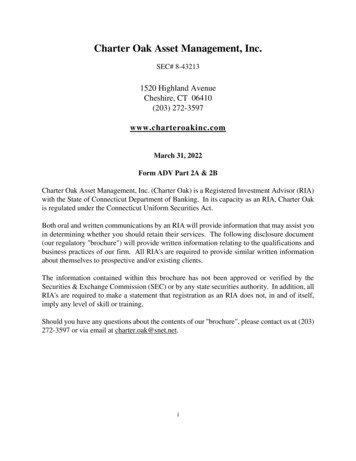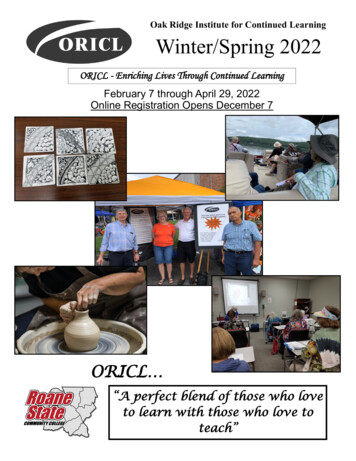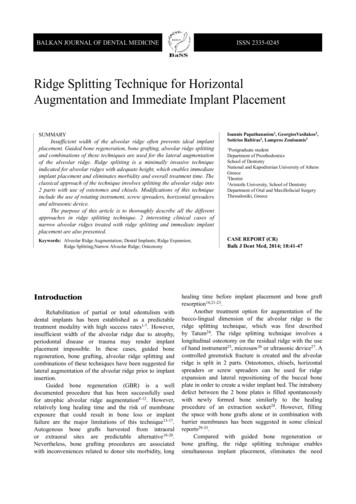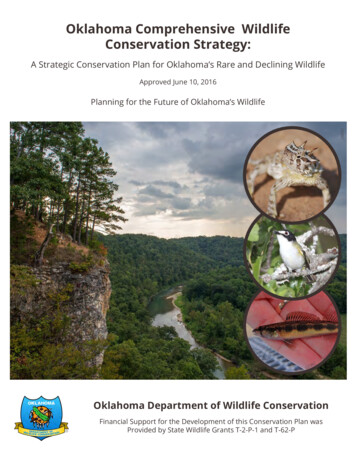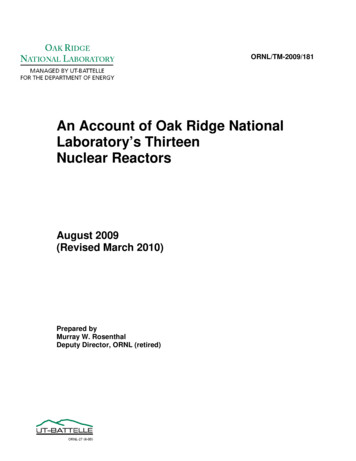
Transcription
ORNL/TM-2009/181An Account of Oak Ridge NationalLaboratory’s ThirteenNuclear ReactorsAugust 2009(Revised March 2010)Prepared byMurray W. RosenthalDeputy Director, ORNL (retired)
DOCUMENT AVAILABILITYReports produced after January 1, 1996, are generally available free via the U.S. Department ofEnergy (DOE) Information Bridge.Web site http://www.osti.gov/bridgeReports produced before January 1, 1996, may be purchased by members of the public from thefollowing source.National Technical Information Service5285 Port Royal RoadSpringfield, VA 22161Telephone 703-605-6000 (1-800-553-6847)TDD 703-487-4639Fax 703-605-6900E-mail info@ntis.govWeb site ts are available to DOE employees, DOE contractors, Energy Technology Data Exchange(ETDE) representatives, and International Nuclear Information System (INIS) representatives fromthe following source.Office of Scientific and Technical InformationP.O. Box 62Oak Ridge, TN 37831Telephone 865-576-8401Fax 865-576-5728E-mail reports@osti.govWeb site http://www.osti.gov/contact.htmlThis report was prepared as an account of work sponsored by anagency of the United States Government. Neither the United StatesGovernment nor any agency thereof, nor any of their employees,makes any warranty, express or implied, or assumes any legalliability or responsibility for the accuracy, completeness, orusefulness of any information, apparatus, product, or processdisclosed, or represents that its use would not infringe privatelyowned rights. Reference herein to any specific commercial product,process, or service by trade name, trademark, manufacturer, orotherwise, does not necessarily constitute or imply its endorsement,recommendation, or favoring by the United States Government orany agency thereof. The views and opinions of authors expressedherein do not necessarily state or reflect those of the United StatesGovernment or any agency thereof.
ORNL/TM-2009/181Office of the Laboratory DirectorAN ACCOUNT OFOAK RIDGE NATIONAL LABORATORY’STHIRTEEN NUCLEAR REACTORSMurray W. RosenthalDate Published: August 2009Revised: March 2010Prepared byOAK RIDGE NATIONAL LABORATORYOak Ridge, Tennessee 37831-6283managed byUT-BATTELLE, LLCfor theU.S. DEPARTMENT OF ENERGYunder contract DE-AC05-00OR22725
CONTENTSLIST OF FIGURES.vLIST OF TABLES . viiFOREWORD. ixACKNOWLEDGMENTS.xABSTRACT . xiTHE BEGINNING AT CHICAGO.1THE OAK RIDGE GRAPHITE REACTOR .3THE EVOLUTION OF ORNL .8SUPPORT OF NON-ORNL REACTORS.Package-Power Program.N. S. Savannah.Gas-Cooled Reactors .11111111AQUEOUS HOMOGENEOUS REACTORS . 14Homogeneous Reactor Experiment . 14Homogeneous Reactor Test . 18AIRCRAFT NUCLEAR PROPULSION PROGRAM . 24Aircraft Reactor Experiment Development . 24ARE Operation . 26MOLTEN-SALT REACTOR EXPERIMENT . 29HEALTH PHYSICS RESEARCH REACTOR . 35MATERIALS TEST REACTOR . 39LOW-INTENSITY TEST REACTOR. 42THE SWIMMING POOL REACTORS .Bulk Shielding Reactor .Geneva Reactor.Pool Critical Assembly .44444546TOWER SHIELDING FACILITY . 48TSR-I . 48TSR-II . 49OAK RIDGE RESEARCH REACTOR. 52HIGH FLUX ISOTOPE REACTOR. 55EPILOGUE . 60BIBLIOGRAPHY . 61APPENDIX A. EVOLUTION OF NUCLEAR REACTORS. 65iii
iv
LIST OF 242526272829303132333435PageFinal layer of the Chicago Pile.The Chicago Pile at the approach to criticality .The Oak Ridge Graphite Reactor and chemical processing pilot plantunder construction in August 1943 .Graphite Reactor fuel slug. .Cutaway view of the Graphite Reactor .Loading fuel into the Graphite Reactor .Pilot plant operations area.The Graphite Reactor in 1947 .ORNL’s nuclear reactors, from criticality to shutdown .Experimental Gas-Cooled Reactor.HRE reflector vessel during construction .Sketch of the HRE reactor vessel.Schematic flow diagram for the HRE .HRT core and pressure vessels .Schematic flow diagram for the HRT .Core vessel for the HRT.HRT building, showing upper shield blocks.Stacked BeO moderator blocks for the ARE .ORNL photograph of molten salt, featured on the cover of the BritishScience Journal in June 1969.ARE core.ARE flow diagram .Sketch of the MSRE.Graphite core of the MSRE.Schematic of the MSRE .MSRE core, fuel circulating pump, and heat exchanger in the primary systemcontainment tank .MSRE air-cooled radiator with its door open .Glenn Seaborg at the MSRE control panel .The DOSAR facility.The HPRR core .The HPRR with phantoms .Details of MTR fuel .Cross section of the MTR .Cutaway view of the MTR.The MTR in operation.Cutaway view of the 43536373940414142
363738394041424344454647484950515253The LITR on the cover of Scientific American.The BSR in its “swimming pool” .Sketch of the BSR, showing the forced cooling piping.The Geneva reactor.Drawing of the PCA in the BSR pool.A reactor and shield suspended at the TSF.TSR-II core .TSR-II cross section .TSR-II suspended from the TSF towers .Cutaway view of the ORR.Pool-side view of the ORR .The ORR in its “confinement” building .The HFIR and other facilities in Melton Valley .HFIR fuel element with target rods in the flux trap.Cross section of the HFIR at the horizontal midplane.Replacement of HFIR fuel element .The operating gallery of the Transuranium Processing Facility.ORNL today .vi434445464748495051525354555657585859
LIST OF TABLESTable123456PageGraphite Reactor parameters.Reactors built and operated at ORNL .HRE parameters .HRT parameters .ARE parameters .MSRE parameters .vii3816182529
FOREWORDThe Oak Ridge Institute for Continued Learning has sponsored a series of lectures in honor ofAlvin Weinberg, former director of Oak Ridge National Laboratory (ORNL). In 2008 I was asked togive one of those lectures on ORNL’s nuclear reactors. In preparing for the lecture, I realized thatthere is no single publication that covers all of the reactors. Since I had collected a lot of material, Idecided to fill the gap with this report.The best single source of information on ORNL reactors is Weinberg’s enjoyable autobiography,The First Nuclear Era. In it he tells how each one came about and describes its accomplishments.Another very useful account is A Brief History of the Research Reactors Division, compiled byD. R. Stapleton. It describes all of the research reactors.To go deeper requires reading in many reports and papers, and for the big programs, theirquarterly reports. The bibliography lists many of the books, papers, and reports that I dug into. Whilethis report is principally about reactors built at ORNL, I briefly describe roles that the Laboratoryplayed in reactors built elsewhere. I also mention some earlier events and, consequently, list in thebibliography several books that are sources of pre-ORNL history, including especially RichardRhodes’ prize-winning book, The Making of the Atomic Bomb.The design and construction of the reactors, and particularly the power-reactor experiments, werepreceded and accompanied by essential supporting research and development programs that spanneda wide range of scientific and engineering disciplines. Everything from basic chemistry to the testingof valves was carried out by multidisciplinary teams who worked together to develop solutions tocritical problems. I concentrate on the reactors themselves and say little about the programmaticsupport, but it is covered in many publications, including the periodic reports of the programs anddivisions. I also omit any discussion of the removal of reactors and the cleanup of their sites after theywere shut down. The U.S. Department of Energy established a separate program to manage this task,and it is far along, although not entirely finished.The reader will notice that I mention few names. There are far too many for me to have listedthem all, and often I did not have enough personal knowledge to single out those most deserving ofcredit. However, the histories of ORNL divisions in the bibliography do list the people and what theydid, and Weinberg’s book calls attention to a number who played key roles.Many readers will be aware that the Laboratory was originally called Clinton Laboratories, thenClinton National Laboratory, and in 1948 it became ORNL. I use Laboratory and ORNL interchangeably but not the earlier titles. Readers may also know that the Laboratory’s sponsor wasoriginally the U. S. Army, then the Atomic Energy Commission, next the Energy Research andDevelopment Administration, and finally the U.S. Department of Energy.ix
ACKNOWLEDGMENTSI owe thanks to a number of people who provided help to me in preparing this history:John Auxier, Sam Beall, Roger Carlsmith, Dick Cheverton, Bob Costner, Dick Engel, Mike Farrar,Paul Haubenreich, John Hill, Leo Holland, Gene McNeese, Harold McCurdy, Bud Perry,Norman Schaeffer, and Jerry Swanks reviewed sections about reactors with which they had beeninvolved. I consulted Bill Appleton, Bill Burch, Fritz McDuffie, Randy Nansted, Jack Richard, andAl Trivelpiece about specific items. Bud Perry helped me understand several issues involving reactorphysics. Dale Claflin of Idaho National Laboratory dug out old sketches of the Materials TestReactor.I am indebted to Bonnie Nestor, Special Assistant to the Director of Oak Ridge NationalLaboratory (ORNL), for assistance in preparing the report for publication, and to Joy Anderson,ORNL Communications and External Relations, for help in finding photographs. Thanks also goto Jim Roberto, former ORNL Deputy for Science and Technology, for supporting the publication ofthis report.x
ABSTRACTThe Oak Ridge National Laboratory has built and operated 13 nuclear reactors in its 66-yearhistory. The first was the graphite reactor, the world’s first operational nuclear reactor, which servedas a plutonium production pilot plant during World War II. It was followed by two aqueoushomogeneous reactors and two red-hot molten-salt reactors that were parts of power-reactordevelopment programs and by eight others designed for research and radioisotope production.One of the eight was an all-metal fast burst reactor used for health physics studies. All of theothers were light-water cooled and moderated, including the famous swimming-pool reactor that wascopied dozens of times around the world. Two of the reactors were hoisted 200 feet into the air tostudy the shielding needs of proposed nuclear-powered aircraft.The final reactor, and the only one still operating today, is the High Flux Isotope Reactor (HFIR)that was built particularly for the production of californium and other heavy elements. With theworld’s highest flux and recent upgrades that include the addition of a cold neutron source, the44-year-old HFIR continues to be a valuable tool for research and isotope production, attracting some500 scientific visitors and guests to Oak Ridge each year.This report describes all of the reactors and their histories.xi
THE BEGINNING AT CHICAGOIn 1941, Arthur Holly Compton, a physics professor at the University of Chicago, was put incharge of the U.S. effort to develop a plutonium bomb. He quickly collected many of the people whowere involved in the program to work together in Chicago at what for security reasons was called theMetallurgical Laboratory. They included Enrico Fermi, Leo Szilard, Eugene Wigner, and AlvinWeinberg, a 26-year-old biophysics post-doctoral associate.Fermi had been building a series of sub-critical stacks of graphite and uranium that he calledpiles. In the winter of 1942, he and his team assembled the 30th in the series in a squash-racquetscourt at the university. It was large enough and the graphite and uranium were pure enough for it togo critical, and on December 2 it became the world’s first nuclear reactor. However, it had noshielding or cooling, so the power level had to be kept very low.As shown in Fig. 1, the pile was made from graphite slabs with arrays of uranium lumps inalternate layers. Figure 2 reproduces a 1957 painting by Gary Sheahan that was commissioned by theChicago Tribune to commemorate the achievement of criticality.The Chicago Pile was a key step in a chain that led to the creation of the Oak Ridge NationalLaboratory (ORNL), a chain that can be thought of as starting in 1932 with the discovery of theneutron by James Chadwick. Chadwick’s discovery was followed by a series of events that aresummarized in Appendix A.Fig. 1. Final layer of the Chicago Pile. The signidentifies the 19th layer of graphite; portions of layer 18,which contained slugs of uranium oxide, are also visible.(Courtesy of Argonne National Laboratory)1
Fig. 2. The Chicago Pile at the approach to criticality. No photographs exist of the experiment onDecember 2, 1942. This 1957 painting by Gary Sheahan is based on written reports, drawings, andinterviews with the participants. Enrico Fermi is seen on the balcony, directing the operation. (Courtesy ofthe Chicago History Museum)2
THE OAK RIDGE GRAPHITE REACTORGeneral Leslie Groves took charge of the Manhattan Project in September 1942 and immediatelymade the decision to buy 59,000 acres of land in East Tennessee for the Clinton Engineer Works.Early plans called for this area, later known as Oak Ridge, to be the site of the plutonium productionreactors, but in December, DuPont recommended that these reactors be constructed at a more remotesite with more cooling water, and the Hanford site in Washington was selected. However, a monthlater Groves expanded DuPont’s contract to include the building of a smaller reactor and a plutoniumseparation pilot plant in Oak Ridge. Work in Oak Ridge began almost immediately and in a fewmonths was well along, as shown in Fig. 3.Wigner favored water cooling for the OakRidge reactor to make it more of a pilot plant forTable 1. Graphite Reactor parametersHanford, but air cooling seemed easier andPower (heat)1000 kW/4000 kWquicker, with less potential for corrosion of theFuelelements44,000 1 4 in. aluminum-cladfuel cladding, and it was chosen. As indicated inuranium-metal cylindersTable 1, the Oak Ridge pile was a 24 ft graphiteCoolantAircube surrounded by a 7 ft thick shield of highModeratorGraphitedensity concrete. Passing through the graphiteCore24 ft cube with 1248 fuel channelswere 1248 diamond-shaped channels on 8 in.Shield7ft thick high-density concretecenters that at criticality contained 44,000CriticalNovember 4, 1943aluminum-clad uranium “slugs” measuring 1 in.ShutdownNovember4, 1963by 4 in. A sample slug is shown in Fig. 4. Asseen in Fig. 5, cooling air entered and left theFig. 3. The Graphite Reactor and the concrete cells of the chemical processingpilot plant under construction in August 1943. (ORNL History Photo 152)3
channels through gaps between the core and shield.The heated air passed through filters and then wasblown up a tall stack.Passages through the front shield matched thechannels through the core, and the gap between themwas spanned by steel tubes. After removal of shieldplugs, crews standing on an elevator at the front facepushed fresh slugs into the core of the shutdownreactor with long rods, as shown in Fig. 6. Theirradiated slugs dropped into the air gap at the rear ofthe core, where a chute guided them to a 20 ft deepcanal filled with water. Here they were loaded intoFig. 4. Graphite Reactor fuel slug.buckets using long poles and transported underwaterto a cell in the adjacent chemical processing plantshown in Fig. 7.Almost all of the steps involved in separating and purifying plutonium had to be performedbehind thick shielding, so the equipment at the pilot processing plant was contained in a set of sixFig. 5. Cutaway view of the Graphite Reactor.4
cells with 5 ft thick concrete walls. These cells can be seen to the left of the reactor in Figs. 3 and 8.Television was used to view one part of the separation process, but most operations were controlledby observing instruments in the operating gallery shown in Fig. 7.Fabricating and testing the fuel elements turned out to be one of the most acute problems. Initiallybare uranium metal billets were inserted into deep-drawn aluminum cans onto which end caps werewelded. Later the billets were coated with an aluminum-silicon alloy that formed a diffusion barrierand provided a thermally conducting bond. The test of the slugs that proved adequate was heatingthem at 500 C for 10 days and then weighing them to detect any oxidation of the fuel. A review in1948 showed that of 163,661 slugs loaded into the reactor by then, only 48 (representing 0.03%) hadfailed in operation.Fig. 6. Loading fuel into the Graphite Reactor. (ORNL History Photo 69)5
Fig. 7. Operations area of the chemical separations pilot plant. (ORNL History Photo 185)Fig. 8. The Graphite Reactor in 1947. (DOE Oak Ridge Operations Photo 3537)Sets of “regulating,” “shim,” and “safety” rods containing neutron poisons were inserted into thecore from the top and sides. Radiation detection and measurement instruments, many of them newlydeveloped in Oak Ridge, were located in and around the reactor.6
The Pile, which came to be known as the Oak Ridge Graphite Reactor, was completed in9 months. Criticality occurred at 5 a.m. on November 4, 1943, after Fermi and Compton had beenawakened and brought in from town. The design power was 1000 kW, but by blocking unusedchannels, reducing the amount of uranium near the center, and adding additional blowers, it waspossible over time to increase it to 4000 kW.Nearly 2 grams of plutonium was produced in 2 months and shipped to Los Alamos, where testsrevealed a high spontaneous fission rate of Pu-240. The neutrons emitted were concluded to becapable of causing premature detonation, an important discovery that had a major effect on the designof the plutonium bomb.Research facilities were created in the Pile by leaving out some of the graphite blocks, thusforming chambers that were used for the exposure of test materials. Beam holes were provided aswell, and in addition a 6 ft section of the shield on top of the Pile was replaced with a column ofgraphite to create a large radiation source for special experiments.These facilities were used to determine the effects of radiation on materials to be used at Hanford,to measure cross sections and fission product yields and half-lives, to irradiate mice to determinehealth effects, and to conduct other urgent tests. A simulated Hanford fuel channel was installed toinvestigate the effects of radiation on the corrosion of aluminum.The large facility on top of the reactor was used for tests of the laminated steel and Masoniteradiation shields planned for Hanford. Then it was used for measuring nuclear properties in anexperiment involving 35 tons of uranium slugs. Afterwards, responding to Weinberg’s interest, thefuel elements were arranged in lattices in water and the multiplication factors determined. This wasan early step along the path that led to the Materials Test Reactor (MTR) family of research reactorsand to pressurized-water reactors.In early 1945, Los Alamos urgently requested large quantities of radioactive lanthanum—knownas RaLa—for flash radiographic measurements of implosions. A quickly assembled facility separated12.8 d Ba-140 (which decays into 40 h La-140) from the fission products and met the request. Thiswas the first large-scale production of radioisotopes.Key people from the staff who would operate the Hanford reactors and processing plant spenttime in Oak Ridge where special training programs were provided for them. The 1945 Smyth reportstated, “Besides the proving of the pile and the separation plant and the production of several gramsof plutonium for experimental use at Chicago, Clinton, and elsewhere, the Clinton Laboratories havebeen invaluable as a training and testing center for Hanford, for medical experiments, pile studies,purification studies, and physical and chemical studies of plutonium and fission products.”The Pile was run to generate plutonium for processing until early 1945, producing a total of326 g. During this period it was also used for research and for production of other radioactivematerials; these activities continued after the plutonium production mission ended. Other notablework included the pioneering production of radioisotopes; pioneering studies of radiation damage inmaterials; the determination that hafnium-free zirconium has a very low neutron capture crosssection, which led to its being widely used as a reactor cladding material; and the development, byErnest Wollan and Clifford Shull, of neutron diffraction as a research tool, for which Shull received aNobel Prize in 1994.The Pile was shut down in 1963 and designated a National Historical Landmark in 1966. It alsoreceived a Historical Landmark Award in 1973 from the American Society for Metals for itscontributions to the advancement of materials science and technology. And in 2008, the productionand distribution of radioactive isotopes for peacetime use that began at the Graphite Reactor wasdesignated a National Historic Chemical Landmark by the American Chemical Society.7
THE EVOLUTION OF ORNLAlvin Weinberg moved to Oak Ridge in 1945. Eugene Wigner came 6 months later to beResearch Director and began to make the Laboratory into a broad research facility with emphasis onthe technology needed for nuclear reactors. Wigner left in 1947 to return to Princeton University and16 years later received a Nobel Prize; he maintained a continuing relationship with the Laboratory formany years. In 1948 Weinberg became Research Director.Under Weinberg’s leadership, the Laboratory built and operated another 12 reactors that are listedin Table 2 and shown on the bar chart in Fig. 9, where they are grouped by category: gas cooled,aqueous homogeneous, molten-salt, fast burst, and water cooled. Note that the reactors overlap andsometimes several of them were being built at the same time. In this report, they are treated by type,in the order given in Table 2. As a result, the
bibliography several books that are sources of pre-ORNL history, including especially Richard Rhodes' prize-winning book, The Making of the Atomic Bomb. The design and construction of the reactors, and particularly the power-reactor experiments, were
